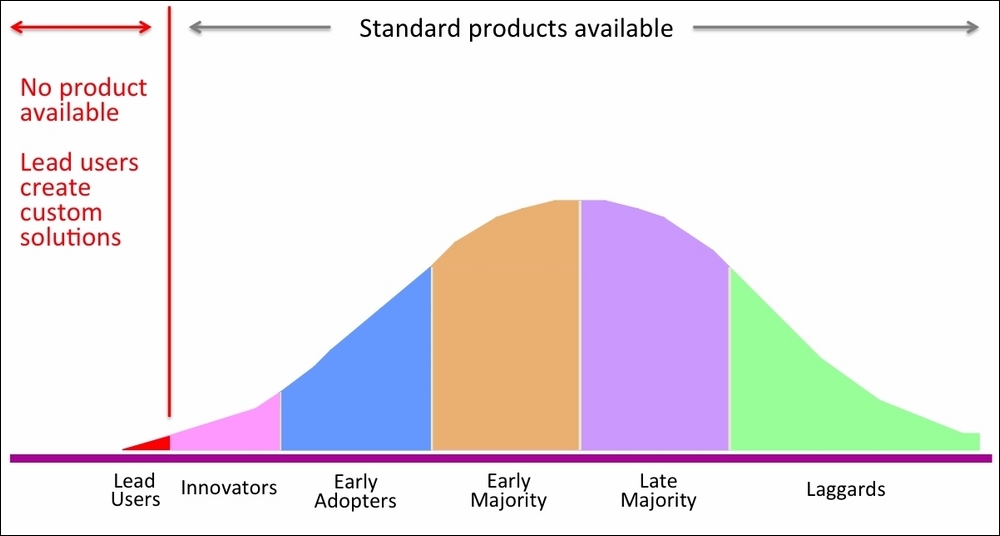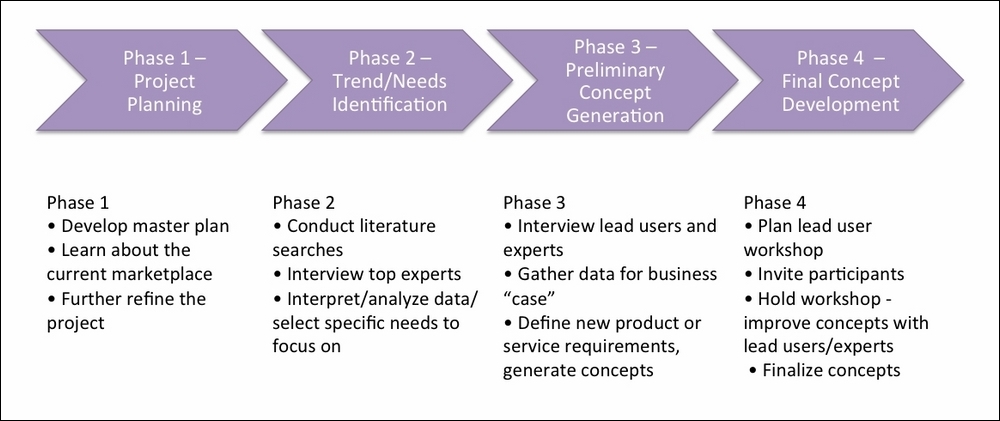As we've discussed, the best companies often work very closely with their customers to uncover wants, needs, and desires that can be translated into new features, improved products, or new service offerings. Companies typically reach out to their current and potential customers to understand what matters most to the people who will ultimately choose whether or not to purchase their products. The lead user research methodology goes a step further, looking not only at the current and potential typical customers, but to those customers and users whose needs and wants lead, and ultimately drive, the market.
These lead users will often have needs the rest of the market does not yet have, and will modify existing products or use your products in unforeseen ways to meet the needs they've identified.

Figure 4.2: Lead user adoption versus the rest of the market
When dealing with the masses, the feedback one often receives is a reticence to change. "This doesn't taste like cola", the focus group proclaimed when evaluating Red Bull. "Only secretaries have keyboards on their desk," they said about PCs. All kinds of great ideas, from the Walkman to nacho chips, originally died in research with average consumers. As Malcolm Gladwell explained to us in his epic book Blink, that's because regular people don't like change very much.
What Malcolm Gladwell didn't tell us is that there are people out there that will gravitate toward a new idea and, sometimes, they even have the new idea for you. Sometimes it is because they are ahead of the curve and sometimes it is because their needs are different. Red Bull didn't taste like a cola, but clubbers loved Red Bull as it helped them rave all night.
The lead-user research method was developed by Eric von Hippel in 1986 as a systematic way to delve into the insights and innovations of these lead users. Von Hippel developed the term, lead user and his definition is:
- Lead users have new product or service needs that will be general in a marketplace, but they face them months or years before the bulk of the market encounters them.
- Lead users expect to benefit significantly by finding a solution to their needs. As a result, they often develop new products or services themselves because they can't find a solution to their problem in the marketplace.
As Eric von Hippel remarked, "This is not traditional market research—asking customers what they want. This is identifying what your most advanced users are already doing and understanding what their innovations mean for the future of your business". Von Hippel went on to say that a lead user is motivated to innovate in order to solve his or her own problems rather than to sell a product or service. What was truly remarkable about von Hippel's research is the observation that, in certain industrial fields, innovations most often come from users. As an example, 100% of "first of type" innovations in scientific instruments and semiconductor process equipment during the research period came from users. Of course, in this context a user could be an individual, a group, or a company. But lead users do not just come from technology markets. We all know of many examples such as Robert Weinreb, founder and president of the Tenba Bag Company, who developed breakthrough innovations in ergonomic camera bags. He had been a photographer who desperately needed a flexible, special-purpose, and lightweight, protective equipment bag to take on photoshoots. There was no bag that fit the needs Mr. Weinreb had on the market, so he designed and manufactured his own, and has since become a major seller of camera equipment bags.
Very few people are aware of this, but lead users can have profound affects on us all. The following is an excerpt from Technology Review in July 1996
"Berners-Lee did not set out to invent a contemporary cultural phenomenon; rather, he says, "It was something I needed in my work." He wanted to simply solve a problem that was hindering his efforts as a consulting software engineer at CERN. "Berners-Lee's innovation was to apply hypertext to the growing reality of networked computers. He expanded the idea he had developed at CERN and made it available on the Internet in the summer of 1991." | ||
| --Technology Review, July 1996, p.34 | ||
You may or may not know the name Tim Berners-Lee, but it was because of Tim Berners Lee's need for a more robust way to share information with his colleagues over a network that resulted in the World Wide Web, or what we refer to simply as the internet.
As you can see, lead user analysis does have the potential to create some highly innovative and impactful products, but it can also have a significant affect on a company's bottom line. In a recent study, it was found that projects based on the lead user method resulted in eight times higher sales than projects with traditional methods at 3M, a proponent of lead user research. 3M executives went on to say that lead user analysis resulted in "the highest rate of new product line generation in 50 years for the 5 divisions tested".
There are four key differences between lead user research projects and standard market research efforts.
Lead-user research projects:
- Focus on the needs of leading-edge users, not typical or average users
- Seek not only needs but innovations—user-developed solutions to leading-edge needs from users
- Seek needs and solutions in adjacent markets and nonobvious adjacent markets in addition to the target market
- Employ a cross-disciplinary team bringing in perspectives from various parts of the organization
In addition to the excellent research Eric von Hippel did, he continued to develop more resources for lead user practitioners. The following is a high-level roadmap you can use to deploy a lead user program in your company. If you need additional reading, Dr. von Hippel also has an excellent lead user project handbook published through MIT at http://web.mit.edu/people/evhippel/Lead%20User%20Project%20Handbook%20(Full%20Version).pdf.

Figure 4.3: Lead user project
- Phase One, preparing to launch the lead-user project: The team plans the project schedule, learns about the current marketplace, and shapes the project focus.
- Phase Two, identifying key trends and customer needs: The team seeks out lead users and lead use experts in order to understand trends that impact the area of study and glean deeper insight into the needs of leading edge users by observing how they are innovating solutions to address gaps in the market. This phase culminates in framing the needs that will be the focus of the next phase.
- Phase Three, exploring lead-user needs and solutions and creating preliminary concepts: The project team continues to find lead users through networking and interviews. The team may make site visits to observe lead users and uncover tacit information. (A lead user may not be aware of the uniqueness or innovative quality of his or her work, and the project team, in observing the user, may glean additional insights.) At the same time, the team generates preliminary solution concepts by putting together insights gleaned from various lead-user innovations and outcomes from team synthesis activities. These solution concepts will be refined further in a workshop with some lead users.
- Phase Four, final concept development and improving solution concepts with lead users and experts: The team invites a select group of lead users and lead use experts to attend a two-and-a half day workshop focused on improving or adding to promising preliminary concepts. The project team takes the concepts generated from the workshop, ties them into the other pieces of the solution, creates a business case, and delivers recommendations to management.
While a lead user project can have significant upsides to the organization for new and innovative product and services, it must be mentioned that a lead user project is a significant investment of an organization's time and financial resources. Typical lead user projects run from 6 to 8 months with a cross-functional team of four to six people all working part time with senior leadership buy-in and support. There should also be one or two additional coaches as part of the team, who are knowledgeable about the lead user process.
